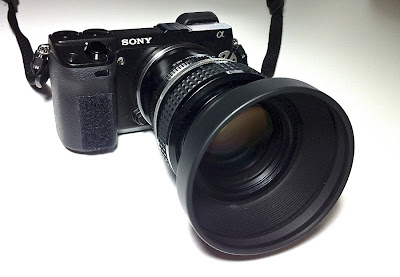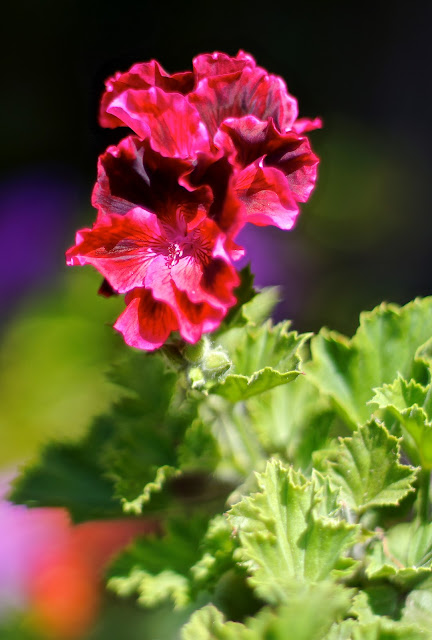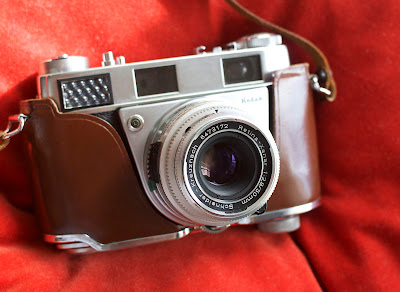If you are interested in the science of optics or physics I'm sure you can find numerous websites explaining Depth Of Field or DOF in technical terms. I'm going to try to keep it simple and practical.
From a practical sense it's quite easy. The larger the aperture the narrower the area of focus. That's it, that was easy.
Of course it can get more complicated the deeper you want to go into the rabbit hole. For instance, the larger the aperture the smaller the f-stop. What? f/1.2 is much larger than f/22
OK, lets step back for a second and first talk about what DOF looks like and why anyone would really care. If you don't know what DOF is I'm 100% sure you've seen it numerous times.
 |
| Example of narrow depth of field. Subject is focused, but everything else is blurred. |
When you see a photo or film where everything is in sharp focus from near to far, it is oftentimes referred to as, deep focus. The person standing in the foreground and the buildings and faraway mountains in the background are all in clear sharp focus - from here to infinity.
Shallow focus is the opposite of deep focus, and is also referred to as narrow depth of field. I'm sure you've seen shallow focus - when an element in the picture is sharp and focused, but everything in front or behind it is a soft blur. It's very similar to the way we see the world.
 |
| Find the sharp focus area. Notice everything in front or behind it is blurred. |
This all leads us to the not so ubiquitous Japanese term: Bokeh. It's what photographers call the "out of focus" area. This blurry area has a prominence bordering on the spiritual. Suffice to say that every photographer has his own opinion on what is considered good bokeh, and all photographers want good bokeh.
Yes, good blur vs bad blur. Bokeh shmokeh, I say it's all subjective. And every lens has it's own bokeh look. Google "bokeh" if you really need to go any deeper.
Let's get back to the easy part - how to achieve, shallow focus or deep focus.
Remember what I said? The larger the aperture (larger hole) the narrower the area of focus. Aperture, also called iris, is the hole or opening through which light travels through the lens and onto the camera sensor.
Iris' can be opened or closed incrementally. The increments are measured in f-stops. The confusing part is that the larger the f-stop number the smaller the hole is. Typically, f/22 is the largest f-stop number you'll find on photo lenses, and it happens to be the smallest hole.
Are you confused yet? Because I'm getting confused just writing about it. OK, here comes the simple explanation:
 |
| Aperture or iris. |
If you want to achieve shallow depth of field you need to open the iris or aperture to its widest opening - smallest f-stop number.
If you want everything to be in focus from here to infinity you have to close your aperture or iris to it's smallest hole - largest f-stop number.
Shit, why didn't I just come out and say that? I kinda did, fourth sentence - up above.
As I mentioned before, why lenses act like they do is a subject beyond the scope of this post. I am not going to get into focal length, hyperfocal distance or DOF formulas. You want enlightenment? Become a Buddhist - or just Google "DOF."
Now let's get into the problems associated with trying to achieve one or the other. The most common snag I can think of is when you're shooting an extremely bright scene, maybe an outdoor scene in bright daylight, and you want to create narrow DOF. The way to get narrow DOF is to open the iris to its widest aperture. Problem is that this might allow too much light to enter the lens and render the photo overexposed.
What can we do? The obvious solution is to increase the shutter speed to compensate for the extra light coming in to the sensor. I've seen scorching bright days where the fastest shutter speed won't be fast enough to get a properly exposed photo. Furthermore, what if you are shooting video on this same extremely bright day and therefore, have limited control of shutter speed?
You want narrow DOF on a brightly lit subject - say it with me - "Neutral Density Filter," commonly referred to as ND filter. Using a neutral density filter is akin to putting on sunglasses. As the name implies neutral density filters are supposed to darken the scene without affecting or changing the color. Neutral.
ND filters gives you the means to darken the scene allowing you to open the iris as much as you need thereby, creating narrow DOF without overexposing the picture. That's optical gold man!
Lets examine the opposite situation. If you need to achieve deep focus on a dimly lit day, slow down the shutter or go get more light on the subject, because your going to have to close the iris as much as you can to get everything in focus.
Let's review:
Shallow depth of field: open the iris or aperture to its widest opening - smallest f-stop number. Too bright? Use an ND filter.
In focus from here to eternity: close your aperture to it's smallest hole - largest f-stop number. Too dark outside? Get some big lights. I know, it's supposed to be infinity not eternity, LOL.
One more thing. The size of the sensor affects DOF. I know you can't change the size of your camera sensor so I didn't get into it here. Suffice to say, larger sensors can give you narrower DOF.
I hope I've explained it well enough; you can always Google it...









































